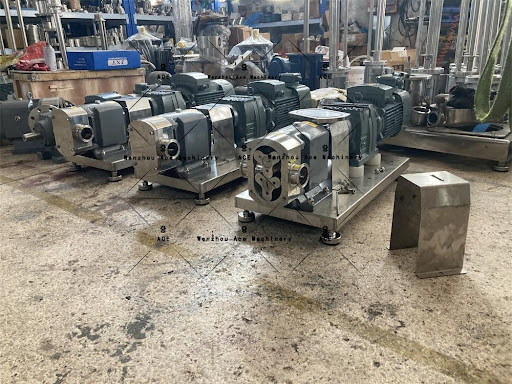Lobe Pump Operations: Everything You Should Master

Lobe pumps are prevalent in many industries. These pumps work on the principle of positive displacement. Two rotors move in the opposite direction to provide with targeted displacement of the liquid. Lobe pumps have the additional benefit of offering a wide range of applications. Comprehension of lobe pump operations helps to achieve the best performance in their application and operational characteristics. Pumpers are present and indispensable in the food, beverage and pharmaceutical industries for pumping viscous or sterile fluids. Knowing lobe pump mechanics will help one focus on the right ones for specific activities. Effectiveness of lobe pumps are improved through maintenance practices.
More Information on Lobe Pumps
If you buy rotor pumps please contact us
info@ace-chn.com
website:https://acelobepump.com
Definition and Basic Principles
What are Lobe Pumps?
Lobe pumps are classified as positive displacement pumps. These types of pumps employ transforming lobes for the transfer of fluids. The structure enabled positive movement of the liquids. Lobe pumps assist in linear transport of fluids of high as well as low viscosity. That is why many industries use lobe pumps because of the flexibility they offer.
How Do They Work?
A lobe pump functions by having two lobes spin. The lobes rotate in opposite directions, creating cavities filled up with fluid. This movement traps the liquid inside. The liquid that is trapped goes around the casing. Touching the lobes are very close to coming to a complete contact but none does so. The arrangement helps to avoid extreme abrasions and provides a smooth flow of the liquid. Lobe pumps operate at a specific pressure in a similar manner to hydraulic. A lobe pump requires little assistance and this improves efficiency in operations.
Key Components
Rotors
The rotors are central elements of lobe pumps. Features that rotate, hence, create movement of fluid. One of the basic principles of rotor designs is to ensure less contact. It enhances the longevity the ideal life of the pumps. Rotor has a very important part in persistence of the flow.
Casing
The casing consists of several parts which enclosing the rotors in lobe pumps. This portion aids in strengthening the pump. It confines, within the pump, the fluid media which is present within it. This component is made in such a way also to ensure there is no spillage. Design cost-effective casing that does not compromise the output of the pump.
Seals and Bearings
In a lobe pump, seals help stop the fluid from escaping. Such parts ensure that the pump remains pressurized. Support is needed for the rotors when the work is in progress and the bearings offer this support. An effective management of seals and bearing is important. To improve the performance of lobe pumps, their pump up should be regularly examined.
Materials and Configurations
Common Materials Used
Stainless steel
Manufacturers of lobe pumps usually pick on the use of stainless steel due to its strength and corrosion resistance. This material does not corrode and can even withstand very high temperatures. Stainless steel offers a clean surface that is suitable for use in food and pharmaceutical sectors. The robust nature of the standard lobe pump allows for the lobe pump to be used for a long duration.
Elastomers
The elastomers are important components in the assembly of lobe pumps. These are readily deformed materials that are employed for effective sealing. Various temperatures and pressures can be accommodated by elastomers. Introduction of elastomers in lobe pumps ensures there are no fluid leakages.
Configuration Types
Single Lobe
In this configuration there is only one rotating lobe. This type of design also allows for quick repairs and at little cost. Single lobe pumps are good in performance and moderate flow rate is achieved. Industries take up single lobe pumps for less complicated operations.
Double Lobe
Double lobe configurations consist of two rotating lobes. This arrangement improves efficiency of fluid movement. The overall performance and flow rate of double lobe pumps is at a higher level. Double lobe pumps are preferred for the most demanding tasks in most industries.
Advantages and Disadvantages
Benefits of Lobe Pumps
Versatility
In terms of the industry reached, lobe pumps allow for incredible flexibility. This explains why lobe pumps have been used in industries such as food processing and pharmaceuticals. It is reported that lobe pumps work very well not only with these fluids but with thick fluids as well. The diversity of the material range that is handled makes lobe pumps even more popular.
Gentle Handling of Fluids
With respect to the product interface, lobe pumps provide good fluid containment and hence low shear stress. In many industries where heat or mechanical stress cannot be applied to both the processes and product. It reduces the chance of damage to the product in the course of dispensing pouch and the structures at that instant.
Limitations
Cost Considerations
Buying lobe pumps up front quite often carries higher initial costs as well. This high costs are as a result of advanced design and materials. The same industries have to consider these costs against the benefits to be gained in the long run. It is likely that the expenditure would be worth it for some of the use cases. In which condition lobe pumps and cost analysis can be utilized.
Maintenance Requirements
In order to achieve optimum performance, lobe pumps need proper maintenance from time to time. Such components include seals and bearings. Those patients will still experience operational limits and therefore lubrication will also prolong the life of lobe pumps. The routine maintenance management of industries is done effectively to avoid delays in production. Some steps as well strategies must be in place for routine maintenance of the industry.
Applications of Lobe Pumps
Sectors Making Use of Lobe Pump
Food and Beverage
Lobe pumps are used in the food and beverage industry for the transfer of fluids. Sauces, syrups, and dairy products, among others, are pumped using lobe pumps with care. Lobe pumps are friendly in operation so that the structure of these products is retained. Lobe pumps are adopted by manufacturers since such pumps do not compromise on hygiene. Lobe pumps are constructed for quick and easy washing.
Pharmaceutical
Lobe pumps are used in the pharmaceutical industry for material transfer applications that require control. Lobe pumps handle delicate materials like creams and gels. The features of dosing and formulation provided by lobe pumps are highly accurate. The usability of lobe pumps is focused towards clean processes and devices in highly regulated environments. Lobe pumps guarantee safety in the production steps of the pharmaceutical industry.
Specific Use Cases
Handling Viscous Fluids
Handling viscous fluid flow is the stronghold of lobe pumps. The lobe pumps are also very strong and can handle dense fluids such as oils and pastes. Efficiency is easy to control in that the hydraulic pumps maintain a constant flow rate. The industry specifically fielded results emphasize the multipurpose nature of lobe pumps in the removal of high viscosity materials. Their capability of lobe pump for such fluids makes them rather useful.
Hygienic Applications
Lobe pumps, are essential in hygienic applications. Contamination is also avoided because of the smooth surfaces of lobe pumps. Lobe pumps work hand in hand with industries that need sterile surrounding for instance the biotechnology industry. There is a peaceful use of lobe pumps which health regulations will still be followed. Lobe pumps present an efficient answer for situations that need a high degree of purity set.
Practical Considerations
Selection Criteria
Flow Rate Requirements
Requirement of flow rate as a criterion while selecting a lobe pump cannot be ignored. Engineers should determine the amount of liquid that has to be moved in a set period. A lobe pump should be appropriate for a flow rate that is required for it to work properly. Careful selection of a pump that has the right flow rate prevents system overload so that it operates in the desired mode.
Pressure Conditions
Pressure conditions very much in elude the selection of a lobe pump. Every application requires a particular pressure that is optimized for good performance. Engineers are required to study the pressure levels of the system prior to pump selection. A lobe pump has to be able to bear up the work pressure in order to prevent damage to it and prolong it.
Proactive Measures for Pump Maintenance
Timely and Regular Inspections
In the same way as any other pump, regular inspection is essential to ensure that a lobe pump works in an optimum manner. Wear and tear analysis should target moving devices como rotors, rotors, and seals. Using this approach, expensive repairs due to problems that could have been easily dealt with can be avoided. Continuous supervision guarantees steady operation of the lobe pump.
Recommended Practices Regarding Lubrication
Proper lubrication practice of a lobe pump increases its longevity. The bearings and other dynamic elements should be lubricated sufficiently to avoid overheating from friction. The manufacturer’s instructions regarding the type and frequency of lubrication should be observed by the technicians. Improper lubrication leads to increased abrasion, hence it is important to have the correct lubrication practices on a lobe pump.





